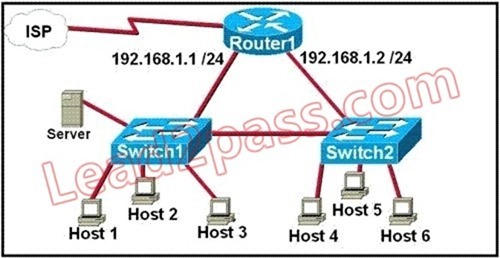2016 September Cisco Official New Released 100-105 Dumps in Lead2pass.com!
100% Free Download! 100% Pass Guaranteed!
The Cisco 100-105 exam is a very hard exam to successfully pass. Here you will find free Lead2pass Cisco practice sample exam test questions that will help you prepare in passing the 100-105 exam. Lead2pass Guarantees you 100% pass exam 100-105.
Following questions and answers are all new published by Cisco Official Exam Center: http://www.lead2pass.com/100-105.html
QUESTION 121
Refer to the exhibit. A network technician is asked to design a small network with redundancy. The exhibit represents this design, with all hosts configured in the same VLAN. What conclusions can be made about this design?
A. This design will function as intended.
B. Spanning-tree will need to be used.
C. The router will not accept the addressing scheme.
D. The connection between switches should be a trunk.
E. The router interfaces must be encapsulated with the 802.1Q protocol.
Answer: C
QUESTION 122
Refer to the exhibit. An administrator replaced the 10/100 Mb NIC in a desktop PC with a 1 Gb NIC and now the PC will not connect to the network. The administrator began troubleshooting on the switch. Using the switch output shown, what is the cause of the problem? 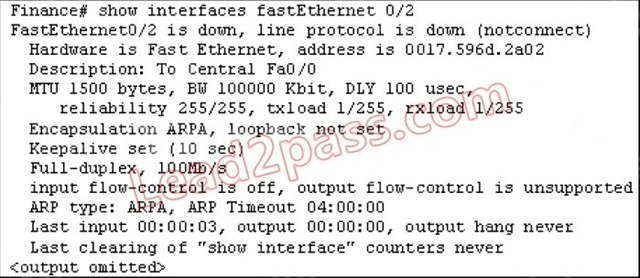
A. Speed is set to 100Mb/s.
B. Input flow control is off.
C. Encapsulation is set to ARPA.
D. The port is administratively down.
E. The counters have never been cleared.
Answer: A
QUESTION 123
Refer to the exhibit. A technician is troubleshooting a host connectivity problem. The host is unable to ping a server connected to Switch_A. Based on the results of the testing, what could be the problem? 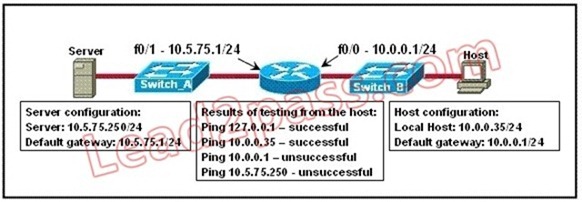
A. A remote physical layer problem exists.
B. The host NIC is not functioning.
C. TCP/IP has not been correctly installed on the host.
D. A local physical layer problem exists.
Answer: D
QUESTION 124
Which statement about IPv6 is true?
A. Addresses are not hierarchical and are assigned at random.
B. Only one IPv6 address can exist on a given interface.
C. There are 2.7 billion addresses available.
D. Broadcasts have been eliminated and replaced with multicasts.
Answer: D
Explanation:
http://technet.microsoft.com/en-us/library/cc757359(v=ws.10).aspx
IPv6 has three types of addresses, which can be categorized by type and scope:
Unicast addresses. A packet is delivered to one interface.
Multicast addresses. A packet is delivered to multiple interfaces.
Anycast addresses. A packet is delivered to the nearest of multiple interfaces (in terms of routing distance).
IPv6 does not use broadcast messages.
Unicast and anycast addresses in IPv6 have the following scopes (for multicast addresses, the scope are built into the address structure):
Link-local. The scope is the local link (nodes on the same subnet). Site-local. The scope is the organization (private site addressing). Global. The scope is global (IPv6 Internet addresses). In addition, IPv6 has special addresses such as the loopback address. The scope of a special address depends on the type of special address.
Much of the IPv6 address space is unassigned.
QUESTION 125
What are two recommended ways of protecting network device configuration files from outside network security threats? (Choose two.)
A. Allow unrestricted access to the console or VTY ports.
B. Use a firewall to restrict access from the outside to the network devices.
C. Always use Telnet to access the device command line because its data is automatically
encrypted.
D. Use SSH or another encrypted and authenticated transport to access device configurations.
E. Prevent the loss of passwords by disabling password encryption.
Answer: BD
QUESTION 126
Refer to the exhibit. A problem with network connectivity has been observed. It is suspected that the cable connected to switch port Fa0/9 on Switch1 is disconnected. What would be an effect of this cable being disconnected? 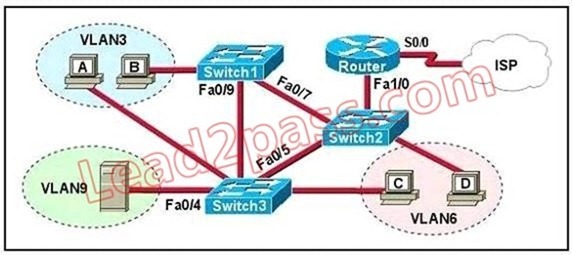
A. Host B would not be able to access the server in VLAN9 until the cable is reconnected.
B. Communication between VLAN3 and the other VLANs would be disabled.
C. The transfer of files from Host B to the server in VLAN9 would be significantly slower.
D. For less than a minute, Host B would not be able to access the server in VLAN9. Then normal network
function would resume.
Answer: D
QUESTION 127
A receiving host has failed to receive all of the segments that it should acknowledge. What can the host do to improve the reliability of this communication session?
A. decrease the window size
B. use a different source port for the session
C. decrease the sequence number
D. obtain a new IP address from the DHCP server
E. start a new session using UDP
Answer: A
QUESTION 128
Which command enables IPv6 forwarding on a cisco router?
A. ipv6 host
B. ipv6 unicast-routing
C. ipv6 local
D. ipv6 neighbor
Answer: B
Explanation:
Enabling IPv6 on Cisco IOS Software Technology
http://www.ciscopress.com/articles/article.asp?p=31948&seqNum=4
The first step of enabling IPv6 on a Cisco router is the activation of IPv6 traffic forwarding to forward unicast IPv6 packets between network interfaces. By default, IPv6 traffic forwarding is disabled on Cisco routers.
The ipv6 unicast-routing command is used to enable the forwarding of IPv6 packets between interfaces on the router. The syntax for this command is as follows:
Router(config)#ipv6 unicast-routing
The ipv6 unicast-routing command is enabled on a global basis.
QUESTION 129
Refer to the exhibit. A host is connected to switch port fa0/3. The host and switch have been fully configured for IP connectivity as shown. However, the indicator LED on switch port fa0/3 is not on, and the host cannot communicate with any other hosts including those connected to VLAN 2 on the same switch. Based on the given information, what is the problem? 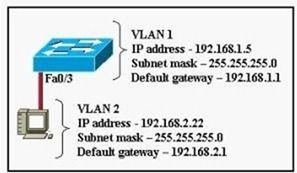
A. switch port fa0/3 is not configured as a trunk port
B. there is a bad cable
C. the switch has been assigned an incorrect subnet mask
D. switch port fa0/3 has been blocked by STP
E. the switch and the host must be in the same subnet
Answer: B
QUESTION 130
Identify the four valid IPv6 addresses. (Choose four.)
A. ::
B. ::192:168:0:1
C. 2000::
D. 2001:3452:4952:2837::
E. 2002:c0a8:101::42
F. 2003:dead:beef:4dad:23:46:bb:101
Answer: ABEF
Explanation:
http://www.intermapper.com/ipv6validator
http://www.ripe.net/lir-services/new-lir/ipv6_reference_card.pdf
QUESTION 131
Which two statements describe characteristics of IPv6 unicast addressing? (Choose two.)
A. Global addresses start with 2000::/3.
B. Link-local addresses start with FE00:/12.
C. Link-local addresses start with FF00::/10.
D. There is only one loopback address and it is ::1.
E. If a global address is assigned to an interface, then that is the only allowable address for the interface.
Answer: AD
QUESTION 132
A network administrator is trying to add a new router into an established OSPF network. The networks attached to the new router do not appear in the routing tables of the other OSPF routers. Given the information in the partial configuration shown below, what configuration error is causing this problem?
Router(config)# router ospf 1
Router(config-router)# network 10.0.0.0 255.0.0.0 area 0
A. The process id is configured improperly.
B. The OSPF area is configured improperly.
C. The network wildcard mask is configured improperly.
D. The network number is configured improperly.
E. The AS is configured improperly.
F. The network subnet mask is configured improperly.
Answer: C
Explanation:
When configuring OSPF, the mask used for the network statement is a wildcard mask similar to an access list. In this specific example, the correct syntax would have been “network 10.0.0.0 0.0.0.255 area 0.”
QUESTION 133
Which statement is true?
A. An IPv6 address is 64 b long and is represented as hexadecimal characters.
B. An IPv6 address is 32 b long and is represented as decimal digits.
C. An IPv6 address is 128 b long and is represented as decimal digits.
D. An IPv6 address is 128 b long and is represented as hexadecimal characters.
Answer: D
QUESTION 134
To allow or prevent load balancing to network 172.16.3.0/24, which of the following commands could be used in R2? (Choose two.) 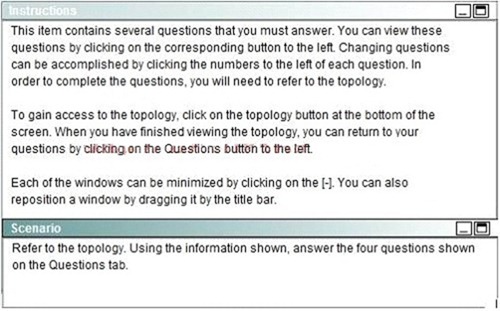
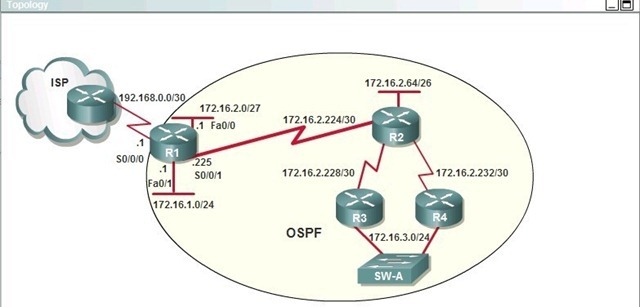
A. R2(config-if)#clock rate
B. R2(config-if)#bandwidth
C. R2(config-if)#ip ospf cost
D. R2(config-if)#ip ospf priority
E. R2(config-router)#distance ospf
Answer: BC
Explanation:
http://www.cisco.com/en/US/tech/tk365/technologies_white_paper09186a0080094e9e.sht ml#t6
The cost (also called metric) of an interface in OSPF is an indication of the overhead required to send packets across a certain interface. The cost of an interface is inversely proportional to the bandwidth of that interface. A higher bandwidth indicates a lower cost. There is more overhead (higher cost) and time delays involved in crossing a 56k serial line than crossing a 10M Ethernet line. The formula used to calculate the cost is:
Cost = 10000 0000/bandwidth in bps
For example, it will cost 10 EXP8/10 EXP7 = 10 to cross a 10M
Ethernet line and will cost 10 EXP8/1544000 =64 to cross a T1 line.
By default, the cost of an interface is calculated based on the bandwidth; you can force the cost of an interface with the ip ospf cost <value> interface subconfiguration mode command.
QUESTION 135
After the network has converged, what type of messaging, if any, occurs between R3 and R4? 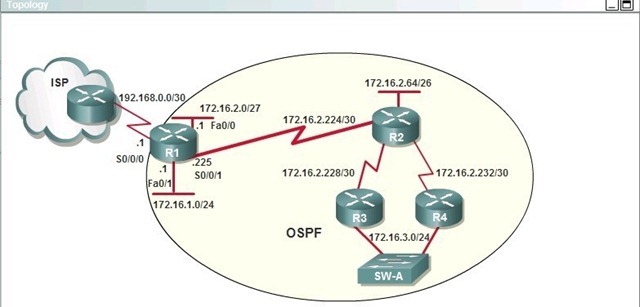
A. No messages are exchanged
B. Hellos are sent every 10 seconds.
C. The full database from each router is sent every 30 seconds.
D. The routing table from each router is sent every 60 seconds.
Answer: B
Explanation:
HELLO messages are used to maintain adjacent neighbors so even when the network is converged, hellos are still exchanged. On broadcast and point-to-point links, the default is 10 seconds, on NBMA the default is 30 seconds.
Although OSPF is a link-state protocol but the full database from each router is sent every 30 minutes (not seconds) -> C and D are not correct.
QUESTION 136
OSPF is configured using default classful addressing. With all routers and interfaces operational, how many networks will be in the routing table of R1 that are indicated to be learned by OSPF? 
A. 2
B. 3
C. 4
D. 5
E. 6
F. 7
Answer: C
QUESTION 137
R1 is configured with the default configuration of OSPF. From the following list of IP addresses configured on R1, which address will the OSPF process select as the router ID? 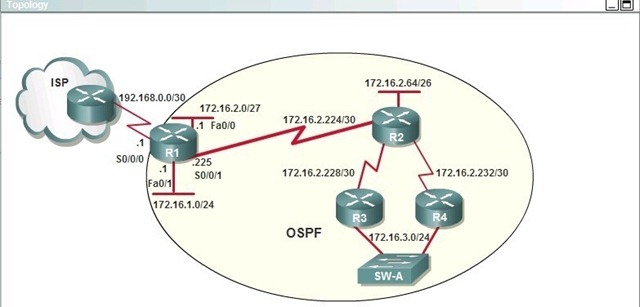
A. 192.168.0.1
B. 172.16.1.1
C. 172.16.2.1
D. 172.16.2.225
Answer: A
Explanation:
The Router ID (RID) is an IP address used to identify the router and is chosen using the following sequence:
+ The highest IP address assigned to a loopback (logical) interface.
+ If a loopback interface is not defined, the highest IP address of all active router’s physical interfaces will be chosen.
+ The router ID can be manually assigned
In this case, because a loopback interface is not configured so the highest active IP address 192.168.0.1 is chosen as the router ID.
QUESTION 138
R1 is unable to establish an OSPF neighbor relationship with R3. What are possible reasons for this problem? (Choose two) 
A. All of the routers need to be configured for backbone Area 1.
B. R1 and R2 are the DR and BDR, so OSPF will not establish neighbor adjacency with R3.
C. A static route has been configured from R1 to R3 and prevents the neighbor adjacency from being established.
D. The hello and dead interval timers are not set to the same values on R1 and R3.
E. EIGRP is also configured on these routers with a lower administrative distance.
F. R1 and R3 are configured in different areas.
Answer: DF
Explanation:
To become OSPF neighbors, routers must meet these requirements: Hello interval, Dead interval and AREA number -> D and F are correct.
QUESTION 139
What information does a router running a link-state protocol use to build and maintain its topological database? (Choose two)
A. hello packets
B. SAP messages sent by other routers
C. LSAs from other routers
D. beacons received on point-to-point links
E. routing tables received from other link-state routers
F. TTL packets from designated routers
Answer: AC
QUESTION 140
ROUTER# show ip route
192.168.12.0/24 is variably subnetted, 9 subnets, 3 masks
C 192.168.12.64 /28 is directly connected, Loopback1
C 192.168.12.32 /28 is directly connected, Ethernet0
C 192.168.12.48 /28 is directly connected, Loopback0
O 192.168.12.236 /30 [110/128] via 192.168.12.233, 00:35:36, Serial0
C 192.168.12.232 /30 is directly connected, Serial0
O 192.168.12.245 /30 [110/782] via 192.168.12.233, 00:35:36, Serial0
O 192.168.12.240 /30 [110/128] via 192.168.12.233, 00:35:36, Serial0
O 192.168.12.253 /30 [110/782] via 192.168.12.233, 00:35:37, Serial0
O 192.168.12.249 /30 [110/782] via 192.168.12.233, 00:35:37, Serial0
O 192.168.12.240/30 [110/128] via 192.168.12.233, 00:35:36, Serial 0
To what does the 128 refer to in the router output above?
A. OSPF cost
B. OSPF priority
C. OSPF hop count
D. OSPF ID number
E. OSPF administrative distance
Answer: A
Explanation:
The first parameter is the Administrative Distance of OSPF (110) while the second parameter is the cost of OSPF.
Lead2pass new released premium 100-105 exam dumps guarantee you a 100% exam success or we promise full money back! Download Cisco 100-105 exam dumps full version from Lead2pass instantly!
100-105 new questions on Google Drive: https://drive.google.com/open?id=0B3Syig5i8gpDWUdDVE1SbVBrb1k
2016 Cisco 100-105 exam dumps (All 274 Q&As) from Lead2pass:
http://www.lead2pass.com/100-105.html [100% Exam Pass Guaranteed]
